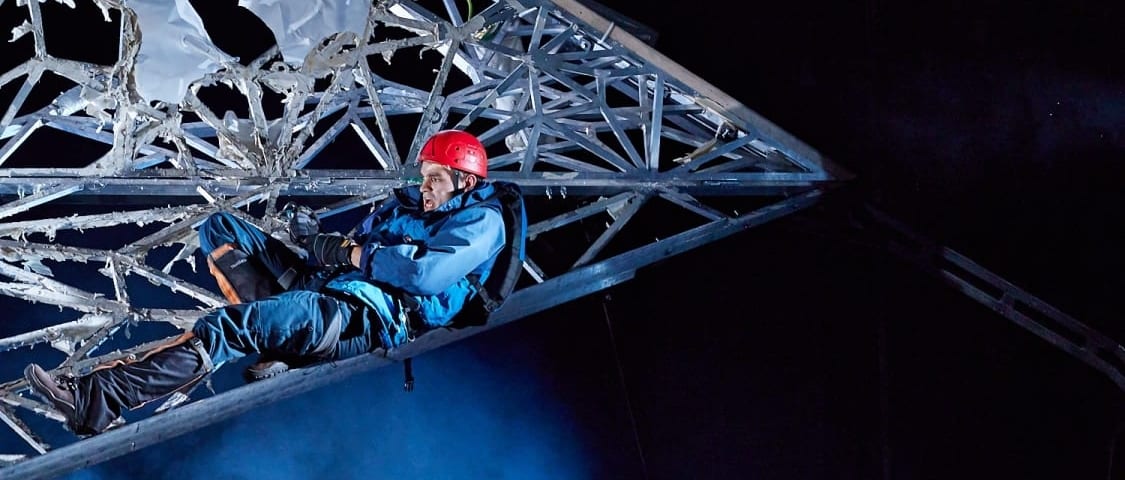This year is the thirtieth anniversary of the publication of Joe Simpson’s remarkable memoir, Touching the Void, later made into an equally successful film. It tells the story of a taxing ascent by Simpson and his colleague Simon Yates of the west face of Siula Grande, one of the most demanding serrated peaks of the Peruvian Andes; and the even more extraordinary experience of the nightmare descent in which Yates had to lower the severely injured Simpson down the mountainside before ultimately cutting the rope after unknowingly lowering him over an overhang which left both of them stranded. Against all odds Simpson survived by crawling out of the crevasse into which he fell, and from there on somehow dragging himself back over glacial moraine to base camp just before Yates departed the mountain.
Not a story that obviously transfers to the stage. But after a very successful run at the Edinburgh Festival this stage adaptation comes to London with high expectations. How far are they met?
For this show to work it has to operate on two levels at the same time and with equal power. The audience needs to understand swiftly what exactly is involved, both physically and mentally, in the business of extreme mountaineering, so that it can appreciate the challenges to be overcome. But also we need to be taken imaginatively to the mountainside both visually and through the personalities of the climbers and their interactions. For the first half of the evening (and the fact that the evening is divided is crucial here) it succeeds brilliantly in juggling all these perspectives; but the second portion is more problematic.
The creative team have taken a number of well-judged decisions at the start which take the audience to the heart of the matter straight away. We begin not on the mountain but in an imaginary wake for Simpson in a Lake District Pub. Here we are introduced to Richard (Patrick McNamee), who was the third member of the expedition, an amateur enthusiast whom Yates and Simpson recruited to help them, and Sarah (Fiona Hampton), Simpson’s sister. It is through these two characters that the audience is taken into the story and the mountaineering mind-set in an economical and visually memorable way, culminating in Hampton’s ascent of one side of the proscenium arch by means of a sequence of tables and chairs attached to the boxes. It is an especially fine example of showing rather than telling.
While the character of the sister is an extrapolation from real life, the device nevertheless works effectively in explaining both the compulsive psychology of climbers and the inevitable cost for those around them. We understand the appeal of an escape from world of mortgages, urban stress, natural deformation, and loss of individual meaning. By the time we get to the mountain we have a better sense of the zone and focus of climbing while there is still someone there to articulate our bewilderment at the vertiginous risks as well.
When we get to the mountain the responsibility shifts to designer Ti Green who devises an elaborate climbing frame that resembles the Louvre pyramid but with torn fragments of paper attached to the struts. This works brilliantly as a means of suggesting the jagged landscape of snow, ice outcrops and sheer, unstable rock faces through which the climbers have to move. The ascent and the traumatic descent are superbly suggested by the two lead actors themselves and the carefully integrated sound and light schemes; though the soundtrack is so loud at times the detail of the dialogue is lost.
Great credit belongs to the actors for suggesting a camaraderie which still falls short of friendship, and a spectrum of emotions under pressure from the elation of summitting through to the fear of imminent death and disaster. It is important that Yates is given equal billing in this section and Angus Yellowlees does a fine job in demonstrating his heroics in masterminding the descent and in presenting the cutting of the rope as an inevitable and logical decision, not the selfish betrayal portrayed in the uncomprehending and ignorant media coverage.
But with the insertion of an interval the play’s own rope is severed and it is harder in the second half to generate the same plausible tension, more especially as the actor’s inevitable lack of mobility reduces the visual resonance of the play. It is no discredit to the scrupulous detailed acting of Williams and Hampton (who returns as psychological goad and encouragement as Simpson begins to hallucinate through lack of food and water) that the last half hour begins to drag. You are also suddenly conscious that a black box theatre would have been a better setting than the blingy jewel-box theatrical context of the Duke of York’s.
This production is a great technical feat by all concerned but it misses a trick in not driving straight through the finishing line with the same preternatural determination displayed by Simpson himself.

